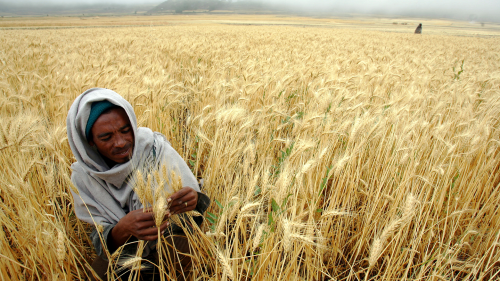Starving for Aid: The Unseen War in Tigray

The Ethiopian government is using starvation as a weapon of war against Tigray, inducing a massive famine that requires immediate action from the international community.
As the war in Ukraine wages on, there has been an outpouring of international support to maintain food exports and imports, and prevent substantial damage to the food system. For Tigray, there’s silence.
A northern region of Ethiopia, Tigray is home to 5.5 million people who are fighting for their lives in a war between the Tigray People’s Liberation Front (TPLF) and the Ethiopian government. What began in November 2020 as a fortification of the Tigray region against a perceived “hostile” central government has degenerated into a violent political conflict inflamed by deep ethnic cleavages. Unable to access desperately needed humanitarian aid, Tigrayans are facing a massive war-induced famine. But there is one key piece of information that people are not talking about enough: the people of Tigray are not just starving, they are being starved, and the international community is doing very little to address this weaponization of hunger and the structural factors that perpetuate it.
Starvation as a Weapon of War
The violent conflict between the Ethiopian government and the people of Tigray is an ethno-political and regional conflict. The relatively confined nature of the conflict to the Tigray region made siege warfare an attractive strategy to the Ethiopian government and its allies. As such, the government of Ethiopia has laid siege to the region and restricted the flow of both people and goods—especially food—in and out of Tigray to force the Tigrayans to surrender. Indeed, there are widespread reports of Ethiopian forces, in coordination with Eritrean troops, blocking and even impounding food aid deliveries to Tigray, destroying farmlands, killing livestock, looting farm equipment, and using military blockades to cut the region’s access to critical farm inputs, such as seeds and fertilizer. It’s no wonder many analysts have accused the Ethiopian government of weaponizing hunger, which the government contends is inadvertent and unintended.
Nonetheless, the resulting food insecurity in the region is becoming increasingly dire. In January 2022, the Tigray Emergency Food Security Assessment by the UN World Food Programme found that after 15 months of conflict, 83 percent (4.6 million people) of Tigrayans are food insecure, a 68 percent increase compared to rates before the war broke out in 2020. Of the 83 percent, two million Tigrayans are severely food insecure. Malnutrition rates are also on the rise, with 13 percent of children under five considered malnourished and 60 percent of pregnant and lactating people. Locals say food prices have risen between 200 to 400 percent, eroding the purchasing power of households and making food even more difficult to access. This qualifies as a famine that rivals the one Ethiopia suffered from in the 1980s, which killed an estimated one million people.
Conditions have only worsened since January. The Ethiopian government has continued blocking major access points to Tigray, leaving the population without needed access to international food assistance. The United Nations was only able to deliver humanitarian cargo on August 22 and 23, and the aid was woefully insufficient; at the time, more than four million people were facing severe hunger in Tigray.
Tigray’s Role in Igniting the Conflict
Not all blame can be placed on the Ethiopian government for the current famine ravaging Tigray; Tigrayan forces have committed similar atrocities during the war, thereby contributing to its weakened food system.
When Prime Minister Abiy Ahmed was elected in 2018, he instituted a new party—the Prosperity Party—and started to remove key Tigrayan government leaders that had been accused of corruption and repression. This created immediate unease among critics in Tigray. Viewing Prime Minister Ahmed’s new party as a threat to the existing federal system, under which Tigray held considerable power, Tigray defied the central government and held its own election in 2020. The Ethiopian government suspended funding for Tigray and cut ties with it a month later, which the Tigrayan government qualified as a “declaration of war.” Tensions continued to increase until Tigrayan forces were accused of attacking army bases to steal weapons, leading the Ethiopian government to take military action.
In addition to provoking the Ethiopian government, Tigrayan forces are reported to have committed serious human rights abuses during the war, some of which amount to war crimes. Tigrayan rebels played a notable role in escalating the violence, including large-scale killings of Amhara civilians, sexual violence, and widespread looting and destruction.
However, the reality is that the Tigrayan people are in an asymmetrical conflict with mounting geographical, military, and structural disadvantages. The Tigray region is bordered by Eritrea, Sudan, and the Ethiopian regions of Amhara and Afar, all of which have frictional history with the Tigrayan people and Tigrayan-dominated Ethiopian governments of the past. Further escalation of the war will disproportionately put Tigrayans at the risk of a genocide.
Ceasefire Offers Hope but with Mixed Returns
On November 2, the Ethiopian government and TPLF signed a peace agreement that purportedly put an end to two years of fighting that killed at least half a million civilians. Ethiopia’s national security adviser to Prime Minister Ahmed, Redwan Hussein, said on November 11 that aid was “flowing like no other time,” including 35 trucks of food. He added that there was “no hindrance whatsoever” to the delivery of aid. The TPLF claims otherwise. As of November 13, TPLF members said that no aid had reached the Tigray region, and that the four main road corridors remained blocked.
When the corridors did finally open—weeks after the peace agreement was signed—an outpouring of aid was expected. Instead, only 15 trucks carrying food aid managed to enter the region on November 14. The United Nations has been unable to obtain unfettered access to Tigray despite the Ethiopian government’s claims of open borders.
It is worth noting that the Ethiopian government did abide by some terms of the peace agreement by restoring power to Mekelle, the capital of Tigray. More than half of Tigrayan troops are also reported to have withdrawn from the frontlines in Ethiopia. These two actions indicate some good faith in the peace agreement, leaving a spark of hope alive that an end to the conflict is possible. Regardless of the positive changes, though, the famine will continue; the ceasefire is too little too late, and it will take years, if not decades, to reverse its effects.
Tigray Attention Pales in Comparison to Ukraine
Tigray is in desperate need of support, yet the international community has taken no serious action to stop the Ethiopian government’s starvation of the Tigrayan people. All attention and the global media are instead focused on the war in Ukraine.
Since February, international actors have committed over $100 billion for the war in Ukraine, approximately $20 billion of which is humanitarian-focused. In Tigray, less than $2 billion has been funded, not even reaching the halfway mark for humanitarian assistance funding requirements. To put it into perspective, the United Nations has confirmed at least 6,595 Ukrainian civilian casualties and tens of thousands of military deaths as of November 21 (although numbers are likely higher). In Tigray, the death toll is astronomically larger, with an estimated total of one million civilian and military deaths.
Neither war can nor should be reduced to mere statistics, yet the numbers illuminate a bittersweet lesson: it is possible to rapidly mobilize support for humanitarian needs, but only when international actors want to. The human-made famine in Tigray simply does not capture the attention of the international community. But why are the lives of Tigrayans somehow worth less than those of Ukrainians? Are their lives less worthy of saving, in the eyes of the Global North? Has the international community chosen to preserve its geographical and ideological values of liberal democracy over its humanitarian responsibility to protect life?
A Call to Action: Ending the Famine in Tigray
The international community has made it overtly clear that the war in Ukraine has taken precedent over that in Tigray, but it is not too late to make a change. International actors can renounce the use of hunger as a weapon of war in Tigray through utilizing existing precedent, such as resolution 2417 of the United Nations Security Council. Condemning starvation and denial of humanitarian access as a method of warfare, the resolution provides a foundation for challenging countries like Ethiopia. Through using sanctions, specifically, other countries can send a clear message to the Ethiopian government that starvation as a weapon of war will not be tolerated.
In addition to taking political action, international actors need to dramatically increase humanitarian aid to the Tigrayan people, especially food aid. They must immediately provide funding to reach the minimum $3.3 billion funding requirement for assistance, and provide substantial food aid through all four corridors into the region. The United States’ $2.5 billion in food aid for Africa announced yesterday at the US-Africa Leaders Summit is a prime example of the action international actors must take, although more aid should be dedicated to Tigray specifically. No single action is a silver bullet, but the combined effects of these efforts by multiple international actors can have swift effects on the Ethiopian government, and can make substantial change that could slow and even reverse the effects of the famine.
Moreover, Ethiopia’s food system has historically been susceptible to famine. Even in peace times, the lack of access to productive agricultural inputs and technologies, and poor rural infrastructure usually consign many within and outside the Tigray region into famine annually. The combined forces of the ongoing conflict, recent drought conditions in the East African region, and inadequate humanitarian assistance are further eroding the hard-earned gains and safety nets made over the past two decades. As we look into the future, international assistance is needed to rebuild Ethiopia’s food systems to make it more productive and resilient to external shocks.
Tigray is facing what could become one of the worst famines on record, and it is completely preventable; the Ethiopian government, in collaboration with Eritrea, is committing genocide of the Tigrayan people by means of starvation. The international community must wake up and act immediately to end the war and save Tigrayan lives.



